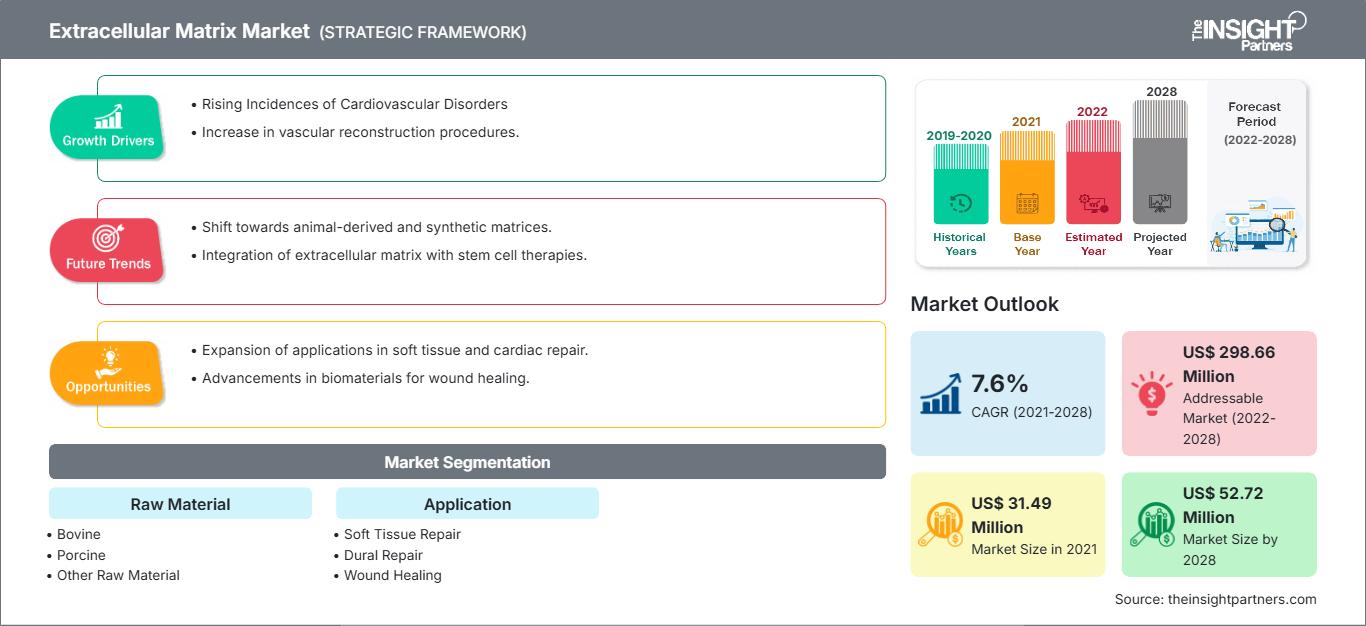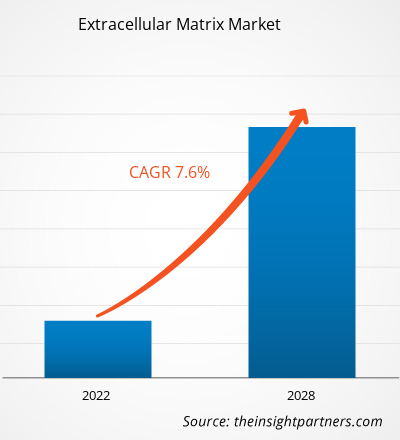Se proyecta que el mercado de la matriz extracelular alcance los 52,72 millones de dólares en 2028, desde los 31,49 millones de dólares en 2021. Se estima que crecerá a una CAGR del 7,6 % entre 2021 y 2028.
La matriz extracelular está presente en la superficie externa de los tejidos y ayuda a estos a unirse a las células mediante colágeno. Está compuesta por proteínas estructurales, glicoproteínas, glicosaminoglicanos y proteoglicanos. La matriz extracelular permite la regeneración de las células receptoras, por lo que se utiliza en diversas aplicaciones, incluyendo procedimientos de reparación cardíaca y vascular. Diversos factores, como el aumento significativo de la incidencia de enfermedades cardiovasculares y traumatismos, y el incremento de los procedimientos de reconstrucción vascular, están impulsando el crecimiento del mercado de la matriz extracelular. Sin embargo, las dificultades en el uso de la matriz extracelular descelularizada obstaculizan su crecimiento.
Recibirá personalización de cualquier informe, sin cargo, incluidas partes de este informe o análisis a nivel de país, paquete de datos de Excel, y además aprovechará grandes ofertas y descuentos para empresas emergentes y universidades.
Mercado de la matriz extracelular: perspectivas estratégicas

-
Obtenga las principales tendencias clave del mercado de este informe.Esta muestra GRATUITA incluirá análisis de datos, desde tendencias del mercado hasta estimaciones y pronósticos.
Perspectivas del mercado
El aumento de la incidencia de trastornos cardiovasculares y traumatismos impulsa el crecimiento del mercado de la matriz extracelular.
El aumento significativo de casos de traumatismos ortopédicos y enfermedades cardiovasculares es el principal factor que impulsa el crecimiento del mercado global de la matriz extracelular. Como parte del tratamiento, la matriz extracelular ofrece diversos beneficios en el tratamiento de diversas lesiones crónicas causadas por cirugías, accidentes, enfermedades crónicas y otros incidentes. Además, la incidencia de insuficiencia cardíaca e infarto de miocardio está aumentando entre la población de edad avanzada. El tratamiento mínimamente invasivo para estos procedimientos cardiovasculares requiere una matriz extracelular. Un paciente con cardiopatía no logra restaurar las propiedades funcionales del tejido cardíaco. La capacidad de la matriz extracelular para regenerarse y promover la reparación y regeneración adaptativa permite a los pacientes recuperar sus funciones normales. Además, ha mostrado resultados clínicos prometedores para la ingeniería de tejidos en el tratamiento de enfermedades cardiovasculares y otras afecciones.
Además, se espera que la creciente incidencia de enfermedades cardiovasculares impulse el crecimiento de la matriz extracelular. Por ejemplo, según datos de la OMS publicados en 2019, se estima que 17,9 millones de personas murieron por ECV en 2019, lo que representa el 32 % de todas las muertes mundiales. De estas muertes, el 85 % se debieron a infartos de miocardio y accidentes cerebrovasculares. Según el informe de Estadísticas Europeas de Enfermedades Cardiovasculares de 2017, en Europa, cada año las enfermedades cardiovasculares (ECV) causan 3,9 millones de muertes, y más de 1,8 millones en la Unión Europea (UE).
Perspectivas basadas en materias primas
Según la materia prima, el mercado de la matriz extracelular se segmenta en bovino, porcino y otras materias primas. Se espera que el segmento porcino ocupe la mayor cuota de mercado, mientras que el segmento bovino registrará la mayor tasa de crecimiento anual compuesta (TCAC) durante el período de pronóstico.
Según la aplicación, el mercado de la matriz extracelular se ha segmentado en reparación de tejidos blandos, reparación dural, cicatrización de heridas, reparación cardíaca, reparación pericárdica y reparación y reconstrucción vascular. Se espera que el segmento de reparación de tejidos blandos alcance una mayor cuota de mercado en 2021. Sin embargo, se espera que el segmento de reparación y reconstrucción vascular registre una mayor tasa de crecimiento anual compuesta (TCAC) durante el período de pronóstico.
Varias empresas que operan en el mercado de la matriz extracelular están adoptando estrategias de marketing, como lanzamientos de productos, fusiones y adquisiciones, colaboraciones, innovaciones de productos y expansiones de carteras de productos para expandir su presencia en todo el mundo, mantener la marca y satisfacer la creciente demanda de los usuarios finales.
Perspectivas regionales del mercado de la matriz extracelular
Los analistas de The Insight Partners han explicado detalladamente las tendencias regionales y los factores que influyen en el mercado de la matriz extracelular durante el período de pronóstico. Esta sección también analiza los segmentos y la geografía del mercado de la matriz extracelular en Norteamérica, Europa, Asia Pacífico, Oriente Medio y África, y Sudamérica y Centroamérica.
Alcance del informe de mercado de matriz extracelular
| Atributo del informe | Detalles |
|---|---|
| Tamaño del mercado en 2021 | US$ 31,49 millones |
| Tamaño del mercado en 2028 | US$ 52,72 millones |
| CAGR global (2021-2028) | 7,6% |
| Datos históricos | 2019-2020 |
| Período de pronóstico | 2022-2028 |
| Segmentos cubiertos |
Por materia prima
|
| Regiones y países cubiertos |
América del norte
|
| Líderes del mercado y perfiles de empresas clave |
|
Densidad de actores del mercado de la matriz extracelular: comprensión de su impacto en la dinámica empresarial
El mercado de matrices extracelulares está creciendo rápidamente, impulsado por la creciente demanda del usuario final debido a factores como la evolución de las preferencias de los consumidores, los avances tecnológicos y un mayor conocimiento de los beneficios del producto. A medida que aumenta la demanda, las empresas amplían su oferta, innovan para satisfacer las necesidades de los consumidores y aprovechan las tendencias emergentes, lo que impulsa aún más el crecimiento del mercado.

- Obtenga una descripción general de los principales actores clave del mercado de matriz extracelular
Perfiles de empresas
- Anteris
- Aziyo Biologics, Inc
- Grupo Coloplast
- Cook Biotech, Inc
- DSM Biomédico
- Baxter
- Medtronic
- Merck KGaA
- Productos biológicos MTF
- Smith y sobrino
- Análisis histórico (2 años), año base, pronóstico (7 años) con CAGR
- Análisis PEST y FODA
- Tamaño del mercado, valor/volumen: global, regional y nacional
- Industria y panorama competitivo
- Conjunto de datos de Excel
Informes recientes
Informes relacionados
Testimonios
Razón para comprar
- Toma de decisiones informada
- Comprensión de la dinámica del mercado
- Análisis competitivo
- Información sobre clientes
- Pronósticos del mercado
- Mitigación de riesgos
- Planificación estratégica
- Justificación de la inversión
- Identificación de mercados emergentes
- Mejora de las estrategias de marketing
- Impulso de la eficiencia operativa
- Alineación con las tendencias regulatorias






















 Obtenga una muestra gratuita para - Mercado de la matriz extracelular
Obtenga una muestra gratuita para - Mercado de la matriz extracelular